VTG Three Tribes Pottery Vase Signed Emmaline Blake Museum Quality North Dakota
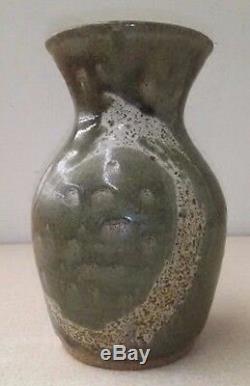
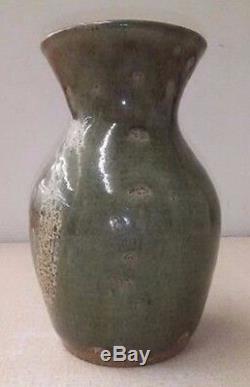
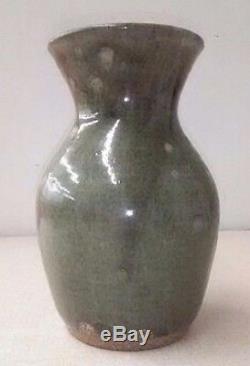
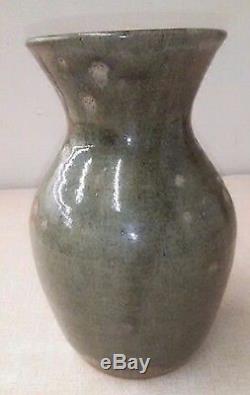
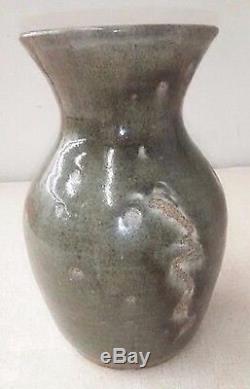
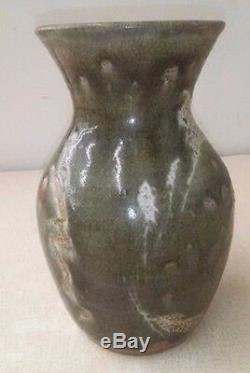

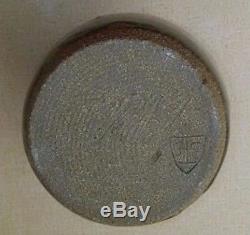

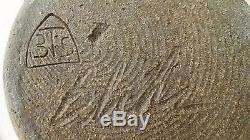
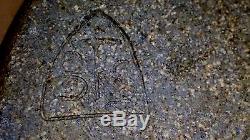
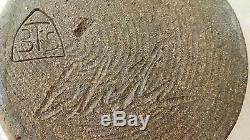

This is a fantastic vase! Emmaline Blake of Three Tribes Stoneware (3TS). It is approximately 7 1/2" tall and 4" wide. Three tribes pottery was produced between 1967 - 1975. This is one of the finest pieces I have seen.
Below is a brief history of the Three Tribes Stoneware studio. Doctor Herbert Wilson and Reverend Ervin Miller, a United Church of Christ Minister, were looking for a economic development project for the Mandan, Hidatsa and Arikara Indians living on the Fort Berthold Reservation. In talking with a number of Indians around New Town they discovered that there was interest in learning to make pottery and having a business of their own. In November of 1966 James Walker an instructor at the University of Wisconsin in Whitewater was contacted and joined the project. He had worked for a summer assisting studio potter, Peter Leach, in St.Paul, Minnesota and also attended Goddard College in Vermont to study pottery making. In January 1967 Walker was in New Town working with Dr. With this grant they began making preparations for the training program. In May 1967 Walker began the 20 week training program which ended October 1967. Pottery production began in December 1967 with three good potters from the Ft.
Berthold culture, that went through the training program, Youngbear, Blake and Elk. In about February 1968 they went from a non-profit training program to a profit corporation manufacturing pottery stoneware. To keep the plant going Walker offered the workers either back salary or interest in the corporation and Youngbear, Blake & Elk took the offer of an interest in the corporation and thereby owning most of the business.Walker and the staff built a large walk-in kiln and most of the other equipment from potters wheels to shelving. The large walk in kiln was 7 feet deep, 6 feet high and 6 feet wide, had four propane burners and would hold 1,500 or more pieces of pottery. Walker bought a small kiln to heat the green ware to 1,800 degrees Fahrenheit which took 8 hours.
This first firing was to give it strength and prepare it for glazing and final firing. The bisque (first fire) ware was then dipped into a liquid which forms the glaze and left to dry for 4 or 5 hours. Then it was put in the large walk-in kiln for the final or second firing. This was a long, high temperature firing (glaze baking), at 2,400 degrees Fahrenheit for about 16 hours and then cooled for 48 hours before removing the pottery. Unlike some pottery plants Three Tribes Stoneware produced no bisque ware.It's final products are all glazed. They did not use molds for any of their pottery, it was done on the potters wheel. Originally Three Tribes Stoneware tried to use clay from the Dickinson area, as the clay was furnished to the plant at cost, but ran into problems because of its low melting point in the kiln, Walker said. Washing of the North Dakota Clay, Walker said, was necessary to remove organic matter therefore eliminating the economic advantage.
Local clay was used only for color. Clay used was high fire clay from Ohio combined with a very plastic ball clay from Maysville, Kentucky and was imported by the boxcar. These clays had the advantage of requiring no grinding, washing or shifting.This was mixed with feldspar to bring down the maturing point of the clay, silica sand to provide strength and water. If properly fired they'll form sturdy decorator pieces or oven worthy cookware. Each batch would yield about 400 lbs. Then the newly mixed wet clay was placed in plastic bags of about 40 lbs. Clay was next taken to the studio for wedging or removal of inconsistencies in texture and air bubbles or pockets by kneading and cutting through it with a wire.
This wedging process must make the clay very even, or any pottery made from it will be defective. Bowls, vases, jugs, cups, cookie jars, casseroles, plates, soup/cereal bowls, flower pots, pencil pots, sugar jars, creamers, ash trays, butter dish, jam jars, tea pots, pitchers, goblets, platters, 10 gallon sauerkraut crocks and candle holders are some of the items made in various sizes, colors and shapes. Some of the colors used were browns, greens, gold, reds, creams, white, blue, grey and blacks.
Some of the pieces were etched speckled designers pieces. The Three Tribes pots, in the muted, natural colors of the barren Dakota plains, have a contemporary, almost Oriental shapes. Some of the places that the stoneware was marketed were in North Dakota, South Dakota, Colorado, Minnesota, Wisconsin and Illinois. Emmaline Blake said 3TS had exhibitions in North & South Dakota, Washington D.
And at the University of Minneapolis. Tell me what you're looking for! I have a lot of stuff and I'm always getting more!Please contact me with any issues before leaving feedback. Please leave 5 star feedback! Many of my items are in as found condition. You may want to clean them before using.
The item "VTG Three Tribes Pottery Vase Signed Emmaline Blake Museum Quality North Dakota" is in sale since Wednesday, August 24, 2016. This item is in the category "Collectibles\Cultures & Ethnicities\Native American\ US\1935-Now\Pottery".
The seller is "kingoplush" and is located in Minneapolis, Minnesota. This item can be shipped worldwide.- Provenance: Signed Studio Pottery
- Artisan: Emmaline Blake
- Origin: North Dakota
- Country/Region of Manufacture: United States
- Tribal Affiliation: Dakota

